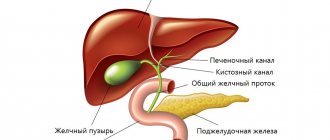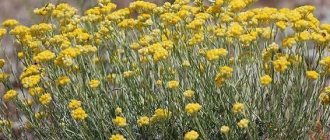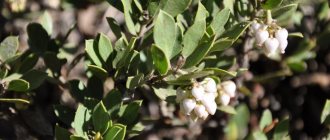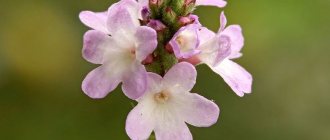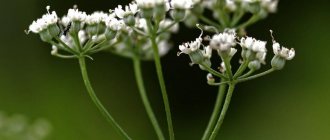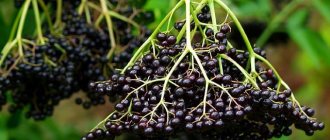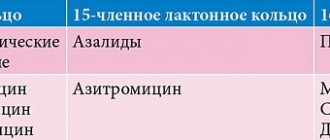Choleretic drugs are often perceived by consumers as light health-improving drugs. But in fact, things are much more complicated - such drugs seriously affect the functioning of the gastrointestinal tract and experimenting with them may be unsafe for health. That is why it is important for the pharmacy worker at the first table to have a clear understanding of how choleretic drugs work and to be able to convey information to the consumer in a simple and understandable form. Let's look at everything in order - from physiological basics to specific questions that should be asked to a pharmacy visitor during a consultation.
Pharmacodynamics and pharmacokinetics
Pharmacodynamics
The plant components of the collection have choleretic, antispasmodic and anti-inflammatory effects. The rich composition and versatile action allows the collection to be used for various concomitant diseases of the gastrointestinal tract.
Menthol is the main component of peppermint oil, has a choleretic effect and enhances intestinal motility.
Yarrow herb has a choleretic, anti-inflammatory, antispasmodic effect, and also enhances the secretion of gastric juice.
Marigold flowers have pronounced bactericidal properties, they are used as an antispasmodic, promote increased bile formation and secretion, and enhance the secretion of gastric juice.
Chamomile flowers are known for their antiseptic and anti-inflammatory effects and are used for flatulence, diarrhea , gastritis with low acidity, colitis and intestinal spasms.
Tansy flowers have a choleretic and antispasmodic effect, improve appetite and digestion. It is used for gastritis with low acidity, diarrhea , intestinal inflammation and flatulence .
Pharmacokinetics
Data not provided.
Choleretic collection 1, 2 or 3: which one to choose
The composition of the collection includes medicinal herbs that prevent bile stagnation. As a rule, they are part of a complex treatment, but they are also recommended for the prevention of pathologies of the liver and biliary system.
Before taking any choleretic drugs, you should definitely seek advice from a specialist, since uncontrolled use of choleretic drugs can lead to very negative consequences.
Ready-made pharmaceutical preparations have not only a choleretic, but also an anti-inflammatory and antispasmodic effect.
№1
It includes the following components:
- Mint. The leaves are rich in tannins, vitamins, amino acids, and essential oils. This makes mint an excellent antiseptic and antispasmodic. Due to its choleretic and analgesic effect, mint is used in the treatment of organs of the biliary system, to destroy gallstones.
- Coriander (seeds). Polyunsaturated fatty acids, vitamins A, C, E, PP, group B, essential oils in the plant give it anti-inflammatory and choleretic properties.
- Immortelle. In folk medicine, its inflorescences are used to treat liver diseases. The flowers contain vitamins, flavonoids, essential oils, and bitterness. It improves the motility of the bile ducts and bladder, has an analgesic effect, and improves bile secretion.
- Three-leaf watch. Its leaves are rich in phytoglycosides, flavonoids, polyunsaturated fatty acids, and pectin. Used as a choleretic, anti-inflammatory and laxative.
Collection No. 1 is recommended for liver diseases, biliary tract dysfunction, pancreatitis.
The drug is contraindicated in case of individual intolerance, stomach and duodenal ulcers, stone formation. Available in cardboard packs or filter bags.
№2
This collection contains the same components, but instead of the three-leaf watch, yarrow herb is included. This plant:
- normalizes bile production;
- relieves spasms of the gallbladder and ducts;
- has an anti-inflammatory effect;
- reduces pain;
- increases immunity.
Instructions for use of choleretic collection 2 contain a description of its effect on the body (anti-inflammatory, antispasmodic, choleretic) and a list of pathologies for which it is used:
- chronic hepatitis;
- dysfunction of the bile ducts and bladder;
- intestinal disorders due to stagnation of bile;
- condition after cholecystectomy.
The drug should not be taken in case of individual intolerance or cholelithiasis. Violating the dosage can cause heartburn.
They produce 30-100 g of crushed herbs in cardboard packs and are sold without a prescription.
№3
The collection contains yarrow and mint, as well as other effective components:
- chamomile, which soothes, reduces pain, spasms, and is effective for stagnation of bile;
- calendula flowers have anti-inflammatory, analgesic, antispasmodic effects;
- Tansy flowers have a pronounced antimicrobial and choleretic effect.
Instructions for use of choleretic collection 3 recommend its use in complex therapy for:
- bile duct dyskinesia;
- chronic hepatitis;
- chronic cholecystitis.
The third collection is contraindicated in case of allergies to these choleretic herbs, certain types of cholecystitis, pregnancy and breastfeeding. It should not be given to children under 12 years of age. Uncontrolled use may cause heartburn.
For those who do not have time to wait and carry out all the manipulations, bags of herbs can be brewed like tea.
Available in cardboard packs of 35 and 50 g, and disposable bags of 2 g in boxes of 10 and 20 pcs. Available without a prescription.
Each of these fees has contraindications and side effects, so the choice of the appropriate one must be left to the attending physician.
Choleretic collection No. 3, instructions for use (Method and dosage)
The decoction is taken orally 1/3-1/2 cup three times a day 40 minutes before meals. The course of treatment is up to 4 weeks. To prepare the infusion, take 2 tbsp. spoons of raw materials per 200 ml of hot water. In an enamel bowl, heat in a water bath for 15-20 minutes, then leave for 35-45 minutes. The raw materials are squeezed out, the infusion is brought to a volume of 200 ml with water. The prepared infusion must be shaken before each use. It has a bitter taste, slightly astringent.
Two filter bags are poured with 100 ml of boiling water and left for 15-20 minutes. For better extraction, press the bags several times with a spoon. After squeezing them, the volume of infusion is adjusted to 100 ml with water. Take 0.5 cups three times a day before meals.
Can it be taken together with other choleretic medications?
Complex treatment of congestion is aimed at removing bile and includes traditional medicines, choleretic preparations, and a therapeutic diet (table No. 5).
Medicines have a narrowly targeted mechanism of action, for example:
- stimulate the production of bile by the liver (Allohol, Cholamin);
- enhance the functioning of the gallbladder (Xylitol, Holosas);
- dilate the bile ducts, relieve spasms (Papaverine, No-shpa, Besalol).
The herbs included in medicinal mixtures 1-3, on the contrary, have a wide spectrum of action and enhance the effectiveness of each other and the tablets. They have a minimum of side effects and contraindications, therefore they are an important component of therapy for bile stagnation. However, you must inform your doctor about taking any medications.
Analogs
Level 4 ATC code matches:
Berberine
Oxafenamide
Cyqualon
Olimethine
Choleretic collection No. 2
Dandelion roots
Holosas
Gepabene
Holenzym
Holagol
Artichol
Holyver
Artichoke extract
Flamin
Tykveol
Odeston
Tanacehol
Allohol
Rose hips , Corn silk , Choleretic mixtures No. 1 and 2 , Kholosas , Holagogum , Curepar , Kholagol , Gepabene , Flamin , Fumetere .
Harm and contraindications
Despite their high therapeutic effectiveness, these drugs have contraindications. For example, the herbs they contain can cause an allergic reaction or a rise in blood pressure, which is dangerous for hypertensive patients. The fees are not used for certain diseases:
- exacerbation of pancreatitis;
- viral hepatitis;
- cirrhosis and liver neoplasms;
- ulcer of the stomach and duodenum.
Gastroenterologists do not recommend taking the preparations for children under 12 years of age. Pregnant and lactating women are prescribed them with caution, only in cases of urgent need.
Long-term use and non-compliance with the prescribed dosage can cause diarrhea, nausea, heartburn, especially in people suffering from chronic gastrointestinal diseases. In these cases, the choleretic preparation is stopped, and the doctor prescribes other drugs.
Reviews of choleretic collection No. 3
Herbal medicine is widely used in the treatment of gastrointestinal . This collection is also called Phytohepatol , which indicates its targeted effect on the liver and biliary system.
Patients respond positively to herbal preparations, and some prefer herbal medicine to pharmaceutical drugs. However, we must remember that it is not always possible to get by only with herbs and often they come as an addition to the main drug treatment. This depends on the severity of the disease and the severity of symptoms. Which choleretic preparation to choose, since there are three of them? This depends on concomitant gastrointestinal , as well as the acidity of gastric juice and the type of biliary dyskinesia .
Medicinal plants are divided into choleretics (increase bile secretion) and cholekinetics (stimulate bile secretion by increasing contraction of the gallbladder).
The first group includes: immortelle flowers, corn silk, tansy, peppermint, elecampane root, yarrow, dandelion root, centaury herb. This group of herbs is taken in the treatment of cholecystitis and associated constipation . Contraindicated in case of cholelithiasis , blockage of the excretory ducts.
The second group includes: calendula, hawthorn flowers, barberry fruits and bark, smoke herb, chicory root, cornflower flowers, rose hips, dill and caraway seeds, lavender, lemon balm. Cholekinetics are indicated for the hypotonic form of dyskinesia , when there is atony of the gallbladder and stagnation of bile, as well as with reduced acidity of gastric juice. Contraindicated for gallstones, acute liver diseases, and exacerbation of hyperacid gastritis .
Collection No. 1 contains immortelle flowers, trefoil leaves, mint leaves, coriander fruits. In this collection, three-leaf watch, due to the presence of bitterness, stimulates the function of the entire digestive tract - the secretion of gastric juice, enzymes and bile. Has a laxative and antiseptic effect. Helichrysum also has the same stimulating effect on the digestive tract, which is effective in the treatment of concomitant colitis and constipation.
In addition to immortelle, mint and coriander (as in the previous one), composition No. 2 includes yarrow. This collection greatly increases the secretion of bile, and the fruits of coriander and yarrow will eliminate constipation.
Choleretic composition No. 3 additionally contains tansy flowers, which increase the acidity of gastric juice, calendula and chamomile, which have a pronounced anti-inflammatory effect. Therefore, it will be effective for inflammation of not only the gallbladder, but also the intestines, as well as gastritis with low acidity and a tendency to diarrhea .
Herbal medicine courses are carried out for a long time (sometimes up to 2–3 months) and are repeated 3–4 times a year. It is necessary to observe the principle of expanding and adding herbs in collections, taking into account the individual tolerance of herbs and the presence of concomitant diseases. If the preparations are selected without taking into account the acidity of the gastric juice (and many have not determined it and do not know it), then in the presence of increased acidity , which will be stimulated even more, heartburn may appear. In most cases, in the absence of allergies, herbal infusions are well tolerated. Many patients note the effectiveness, natural composition and reasonable price.
- “... Not an expensive, effective natural remedy. It always helps me during an exacerbation.”
- “...Pain, heaviness in the right side and discomfort are significantly reduced after 2 days of use.”
- “... In the spring, chronic cholecystitis constantly worsens and I always take this composition. It suits me and doesn’t cause heartburn.”
- “... For mild exacerbations of cholecystitis, I always make do with these herbs. They help a lot."
Why is bile needed?
TANACECHOL® tablets
herbal choleretic drug
It is used as a choleretic and antispasmodic agent for:
- chronic noncalculous cholecystitis
- hypomotor type biliary dyskinesia
- postcholecystectomy syndrome
ADVANTAGES:
- choleretic effect combined with antispasmodic effect
- affordable price
There are contraindications. Specialist consultation required
Bile is produced in the liver by hepatocytes, then accumulates in the gallbladder and is excreted through the common bile duct into the duodenum along with pancreatic secretions. That is, the gallbladder acts as a reservoir and transfers bile to the duodenum.
The chemical composition of bile is represented mainly by bile acids. The composition of bile “in numbers” looks like this:
- bile acids - 35.0 mmol/l;
- bile pigments - 0.8–1.0 mmol/l;
- cholesterol ~ 3.0 mmol/l;
- phospholipids - 1.0 mmol/l.
About 22% of bile is phospholipids. In addition, bile contains proteins (immunoglobulins A and M) - 4.5%, cholesterol - 4%, bilirubin - 0.3%, mucus, organic anions (glutathione and plant steroids), metals (copper, zinc, lead, indium, magnesium, mercury, etc.), as well as lipophilic xenobiotics [1].
The synthesis of these substances occurs during the breakdown of cholesterol and its removal from the human body.
Bile performs two important functions in the body:
- removal from the body of lipophilic components that cannot be excreted by the kidneys in the urine;
- secretion of bile acids, which are involved in the digestion of dietary fat and the absorption of its hydrolysis products.
In addition, bile acids found in bile improve intestinal motility, which naturally prevents constipation. Bile acids also have antiseptic properties and reduce the risk of intestinal infections [2]. Thanks to bile, toxins are removed from the body. In general, any failure in bile transit can cause a lot of trouble. Most often this is:
- nausea;
- pain after eating;
- repeated moderate pain localized in the epigastrium;
- vomit.
What should a pharmacist know?
First of all, which choleretic drugs have a stimulating mechanism of action, which have a contractile mechanism. Depending on the leading mechanism of action, choleretic agents are divided into:
- Choleretics - drugs that enhance bile production;
- cholekinetics - stimulating the flow of bile from the gallbladder into the intestines.
Price, where to buy
You can purchase the collection at any pharmacy. The price of choleretic collection No. 3 in packs of 50 g ranges from 57-73 rubles, the price of raw materials in filter bags is 38-71 rubles.
- Online pharmacies in RussiaRussia
ZdravCity
- Phytohepatol (Cholagogue collection No. 3) 2g filter pack.
20pcs JSC Krasnogorskleksredstva 90 rub. order
